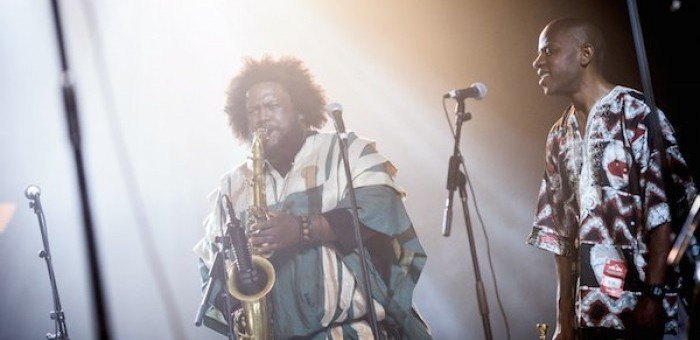Apr 2, 2024 12:59 PM
Saxophonist, Sonic Explorer Casey Benjamin Dies at 45
Casey Benjamin, the alto saxophonist, vocalist, keyboardist and producer who stamped his distinctive sounds on the…

Kamasi Washington (left) and Ryan Porter perform at Where Spaceways Meet: A Night of Spiritual Jazz, part of the Red Bull Music Academy Festival in Brooklyn on May 8.
(Photo: Drew Gurian)In the current climate of reconstituted knowledge—where a list of things you might not know or anything evoking Brian Eno’s name is deemed web-worthy—the Red Bull Music Academy Festival has done a laudable job of introducing young listeners to older, historically significant artists.
Such was the case on May 8 in Brooklyn, when the energy drink’s roving festival brought a pair of saxophone legends from the avant-garde out to share a bill with a young tenor player well aware of the 1960s revolution in jazz.
The long Sunday evening, held in the cavernous Greenpoint Terminal, opened with a stellar set by the Sun Ra Arkestra, followed by Pharoah Sanders with a three-piece rhythm section and finally rising star Kamasi Washington’s octet.
The 10-speaker columns around the perimeter of the industrial space didn’t do much to make the sound engineer’s job any easier. But once they got going, the Arkestra’s horn harmonies were nearly as rich as those of Mr. Ra’s beloved Fletcher Henderson.
Under the direction of saxophonist Marshall Allen, the Arkestra has grown back into a reliably tight and entertaining outfit. And at a fit 91 years of age, the leader was plenty busy on the tall stage erected in the center of the room, conducting the band, cueing them and the engineers for more volume, whispering to individual members, switching between alto sax and EVI electronic horn and otherwise walking around the stage in a splendiferous red and gold sequined shawl and pileus cap. His own playing moved fluidly between pliant blues and screeching noise.
Vocalist Tara Middleton, sporting big glasses, a natural Afro and a big voice, served as the orchestra’s mouthpiece. She belted the gospel of other planes, sometimes drawing on old spirituals for lyrics and eventually employing electronic effects to give her voice added dimensions.
The Arkestra delivered well-honed vamps behind familiar lyrical themes until the end of the set, when they made their time-honored procession into the audience to a calypso rendition of “Space Is The Place/We Travel The Spaceways” sung by Allen and Middleton, resolving with a quick, a cappella interpolation of Nat “King” Cole’s “Hit That Jive, Jack.”
Sanders and company (pianist William Henderson, bassist Nat Reeves and drummer Joe Farnsworth) took the stage next, opening with a smooth ballad that was a bit of a cause for concern—the saxophonist’s output having been inconsistent at best.
The second piece, John Coltrane’s “Olé,” brought his horn closer to the flame and had Washington (who was standing in the wings) executing a knowing nod. The follow-up, “Naima,” brought quick cheers of recognition from the youthful, appreciative crowd.
An upbeat “African Highlights” gave Sanders the opportunity for a careful strut around the stage before “The Creator Has A Master Plan” brought more cheers and closed the set.
Nothing about the ensemble’s appearance was hurried—even Sanders’ occasional screams into the microphone didn’t manage to upset the easy tempo—and his playing, if carefully paced throughout the set, was inspired and on point.
Next up was Washington and his double-drummer octet, who solved the problem of playing in the round by arranging themselves in a circle, all facing inward, and hitting hard.
An initial sequence of bold lines took a quick turn into multi-linear layering and Washington took the first breakneck solo as singer Patrice Quinn danced a small circle on the edge of the band’s larger one. Washington’s playing was assured, with no missteps despite the speed. Even Miles Mosley’s bass solo, switching nimbly between pizzicato and arco, negotiated the brisk tempo without incident.
Washington’s first instrument was the drums and his compositions showed a keen understanding of polyrhythms and Latin beats, cleanly delivered by Tony Austin and Robert Miller.
With a setlist that included “Malcolm’s Theme” (incorporating text written by Ossie Davis for Malcolm X’s funeral) and touching on Freddie Hubbard with “Hub Tones,” the energetic octet showed their hearts clearly belonged with the spirit of the ’60s that permeated the evening. DB

Benjamin possessed a fluid, round sound on the alto saxophone, and he was often most recognizable by the layers of electronic effects that he put onto the instrument.
Apr 2, 2024 12:59 PM
Casey Benjamin, the alto saxophonist, vocalist, keyboardist and producer who stamped his distinctive sounds on the…

“He’s constructing intelligent musical sentences that connect seamlessly, which is the most important part of linear playing,” Charles McPherson said of alto saxophonist Sonny Red.
Feb 27, 2024 1:40 PM
“I might not have felt this way 30 to 40 years ago, but I’ve reached a point where I can hear value in what people…

Albert “Tootie” Heath (1935–2024) followed in the tradition of drummer Kenny Clarke, his idol.
Apr 5, 2024 10:28 AM
Albert “Tootie” Heath, a drummer of impeccable taste and time who was the youngest of three jazz-legend brothers…

“Both of us are quite grounded in the craft, the tradition and the harmonic sense,” Rosenwinkel said of his experience playing with Allen. “Yet I felt we shared something mystical as well.”
Mar 12, 2024 11:42 AM
“There are a few musicians you hear where, as somebody once said, the molecules in the room change. Geri was one of…

Henry Threadgill performs with Zooid at Big Ears in Knoxville, Tennessee.
Apr 9, 2024 11:30 AM
Big Ears, the annual four-day music celebration that first took place in 2009 in Knoxville, Tennessee, could well be…